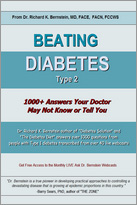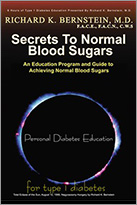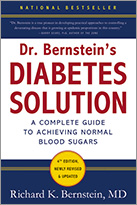by Richard K. Bernstein, M.D., F.A.C.E., F.A.C.N., C.W.S.
November 2007
Diabetes Health
You can make any insulin last longer by injecting a large enough shot. In fact, about 25 years ago, Dr. John Galloway of Eli Lilly and Company performed an important experiment that demonstrated this very fact.
In his experiment, Dr. Galloway injected 70 units of Regular insulin into the arm of a non-diabetic man. To prevent the patient from having serious hypoglycemia, his blood sugar was tested every half hour and glucose was infused into his bloodstream as needed.
Given that the package insert for Regular stated that the insulin would work for four to twelve hours after injection, one might expect that Dr. Galloway could have stopped the glucose drip after twelve hours. As it turned out, however, the subject’s blood sugar kept dropping for a full week, and the glucose drip had to be continued for that long just to prevent him from going low.
It certainly makes sense that a large volume of any liquid injected under the skin will require more time to be fully absorbed by nearby blood vessels than a small volume. When I was young and injected 120 units a day of NPH insulin to cover my high carbohydrate ADA diet, it would take about two weeks for the lump at each injection site to disappear.
The message of Dr. Galloway’s work is apparently very familiar to modern insulin manufacturers who claim 24-hour action for their basal insulin analogues. Of course, several studies have been published to support their claims that both Lantus and Levemir last 24 hours. The single daily injection in these studies, however, is based upon using 0.3 to 0.4 units of insulin per 2.2 pounds (one kilogram) of body weight. For a 154-pound person, this comes to 21 to 28 units per daily injection.
In my experience, a proper basal dose for a 154-pound, non-obese, non-pregnant person with type 1 diabetes (without a history of insulin resistance from PCOS, iron overload, low testosterone in males, etc.) is usually about 12.5 to 15 units daily. If you have high muscle mass, it may be lower.
Lantus is the only basal insulin I use for my patients because, in my opinion, it lasts slightly longer than Levemir. So a 154-pound person would take approximately 7 units of Lantus in the morning and 7 units at night. If you are a type 1, you can check this by correcting the dose for your body weight and then injecting half the dose upon rising and half at bed time. If you fast for 24 hours, this amount of Lantus insulin should keep your blood sugar close to level. That is the purpose of basal insulin, which should be used solely to prevent blood sugar increases while fasting.
By performing their clinical trials using doses that are larger than true basal amounts, insulin makers have persuaded the FDA that one shot lasts 24 hours. Now, with the blessing of the FDA, they are forcing people who follow their dosing guidelines to eat through the day, in order to prevent hypoglycemia by covering the excess basal insulin with food – just as Dr. Galloway covered the unneeded insulin with a glucose drip.
I teach my patients to use basal insulin correctly so that its sole function is to prevent blood sugar increases while fasting. I show them how to use the faster insulins to cover their food. I’ve been studying the action of insulin closely in my patients for more than 25 years. In my experience, and in that of all but two of my insulin – using patients, no long-acting insulin lasts a full 24 hours when administered in proper basal doses.
Unfortunately, there are now only two basal insulins available in the U.S. I find that even when Lantus is split into two doses, the bedtime dose barely lasts nine hours overnight.* As a result, my patients who wish to sleep late on weekends must arise after 8-1/2 hours of sleep, take their morning shot of long-acting insulin, and then go back to sleep. Many must also take a small dose of rapid-acting insulin as a stopgap while the long-acting insulin gets started.
The large “basal” doses needed to make “long-acting” insulins last 24 hours have the potential for a number of undesirable consequences. These include hypoglycemic episodes, weight gain, and possible vascular effects. The weight gain results both from overeating to cover the hunger caused by low blood sugar and from the anabolic (tissue building) effect of insulin. While small physiologic amounts of insulin foster a healthy vascular system independent of blood sugar effects (endothelial flexibility, reduced vascular leakage, etc.), excessive insulin levels adversely affect the vasculature.
* This is due in part to the “dawn phenomenon,” described on pages 93 and 94 of my book, ‘Diabetes Solution’.




